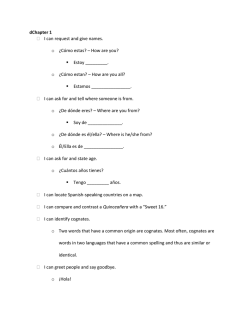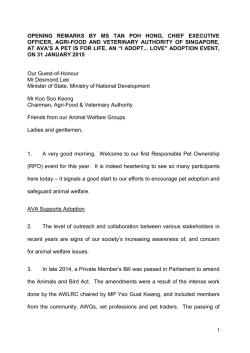
An Update on the Future of Payments Technology
An Update on the Future of Payments Technology A White Paper by Norm Merritt CONTENTS Introduction 01 The Great Re-Terminalization of 2015: EMV and NFC Combine to Drive Change 02 EMV vs. Apple Pay vs. CurrentC: Apple Pay May Have an Edge The world of payments technology can be confusing at the best of times, and with the burgeoning mass adoption of Apple Pay™, NFC, EMV, and potentially CurrentC, 2015 is shaping up to be a year of sweeping change. It has never been more important for business owners to make informed choices and get the right technology into their stores and restaurants. ShopKeep’s president and co-CEO, Norm Merritt has taken some time to put together this white paper which explains the new technologies that are coming, discusses the driving forces behind consumer and merchant adoption, and shares some thoughts on what these changes mean to the industry. Norm Merritt is the president and co-CEO of ShopKeep and a passionate advocate for small businesses. Before joining ShopKeep, Norm was CEO and president of iQor, a multinational Customer Care firm with 17,000 employees. Norm Merritt The Great Re-Terminalization of 2015 01 THE GREAT RE-TERMINALIZATION OF 2015: EMV AND NFC COMBINE TO DRIVE CHANGE The payments industry is known for embracing the world of obscure jargon with gusto, so it’s no surprise to hear that the latest buzzword, ‘re-terminalization’ is enjoying widespread adoption. This monument to obfuscation is now joining ‘chargeback’, ‘interchange’, ‘net settlement’, and others in a list of terms that seem expressly designed to confuse the average merchant. The fact that this term badly needs a rebranding, however, shouldn’t detract from the momentous change and opportunity that awaits the payments industry in 2015. Re-terminalization refers to the process of businesses replacing their existing point of sale system with new technology and America is about to see a bigger wave of change than 5 6 The Great Re-Terminalization of 2015 The Great Re-Terminalization of 2015 we’ve seen in many decades. The cause of this change can be found in Recent point of sale security breaches at Home Depot, Supervalu, the burgeoning adoption of two payment technologies, EMV (EuroPay, and Target have brought to the front pages something that has been MasterCard, Visa) and NFC (Near F ield Communication). The interesting a quietly acknowledged industry secret for some time: America is the thing is that neither of these technologies are really new. In fact, while weak link of credit card fraud and is long overdue for a major payment America has been slow on the uptake, EMV has been widely adopted security upgrade. The United States currently accounts for more across the globe for almost a decade and NFC has been ‘on the cusp’ than 50% of the world’s credit card fraud despite only processing 25% of revolutionizing payments for years. Nevertheless, both of these of card the world’s transactions. It’s that simple fact that has led technologies are almost certainly going to enjoy widespread adoption Visa to finally call time on the card swipe and usher in an era of the over the coming year. EMV ‘chip’ cards. So, What’s at the Root of this Sudden Interest in EMV/NFC? A Little Background: What are Chip Cards and Why are they Better? Unless you’ve been living under a rock for the last month or so, by now EMV, named for the three card companies that created it (Europay, you’ve heard that Apple has launched its very own payments product, MasterCard, Visa), is a technology that stores customer payment Apple Pay. All new iPhone 6 and iPhone 6 Plus models are shipping with details in a card chip rather than on the magnetic stripe on the back of an NFC-enabled chip that allows consumers to pay with their phone by the card. It is deemed to be more secure than previous technologies simply tapping on an NFC-enabled reader. Several companies, including because each time the chip is read, it presents a unique identifier. Silicon Valley ubergiant Google, have tried and failed to stimulate This is important as it drastically reduces the benefit of cloning that adoption of NFC technology, and yet analysts are predicting far greater captured data. results this time around. This is partly due to Apple’s perceived unique ability to shift consumer behavior; it’s partly down to their proactive approach enlisting big-box retailers prelaunch; and it’s partly a product of their collaborative approach to payment processors. All of this, however, still doesn’t completely address the key reason U.S. merchants will finally embrace NFC this year: timing. Apple Pay is hitting the market at a time when EMV acceptance is a hot and pressing topic. 7 8 The Great Re-Terminalization of 2015 There are two key players in the world of credit card fraudsters. The Great Re-Terminalization of 2015 What’s more, Visa has committed to issuing in excess of 600,000,000 EMV cards to consumers in the coming year. So, merchants will soon • • The people who steal card details. This can be through a variety of be confronted with two very compelling reasons to upgrade their means, including sophisticated malware attacks, so-called ‘rubber hardware. The first, a fraud liability shift that leaves non-switchers duckie’ attacks (where the hacker physically attaches a device to the open to substantial risk. And the second, a growing number of security POS system), or relatively basic techniques such as dumpster diving conscious consumers armed with chip cards they believe to be more for discarded papers/cards. secure and expect to be able to use. Visa has essentially drawn a line The people who then attempt to ‘monetize’ that stolen information. This usually involves someone printing stolen details on a new card and trying to use that in-store or online. EMV makes life harder for both sets of players, but in particular, it takes away the ability for stolen data to be used more than once by third parties. There is currently a $15 billion black market in stolen credit card details and EMV is going to dramatically decrease the resale value of each stolen set of card details. So, How is Visa ‘Encouraging’ this Change? in the sand and declared that 2015 will be the year when EMV finally takes hold. Businesses will follow suit. “ There is currently a $15 billion black market in stolen credit card details” Mass consumer adoption will take some time. You could say that 2015 is The world’s largest card issuer, Visa, has suggested a deadline going to be the beginning of the beginning for mobile payments, but the of October 2015 for all U.S. merchants to start accepting EMV payment. enormous hurdle of merchant adoption will soon be overcome. Businesses And their ‘suggested’ deadline has a bite to it; any merchant (excluding across the country are now waking up to the pressing need to invest in fuel retailers) who has failed to invest in EMV deployment may be liable their point of sale systems, and are beginning to research the available for cardpresent counterfeit fraud losses. Where processors and card hardware options. Hence, Apple’s perfect timing. As merchants look to issuers were previously swallowing the fallout from credit card fraud, implement EMV hardware, they will be confronted with a negligible extra these losses will now be taken on by the merchants themselves. cost to also implement NFC readers in their new system. It is this ‘perfect storm’ of EMV and NFC pressures that is going to lead to a landmark year for re-terminalization in 2015. 9 EMV vs. Apple Pay vs. CurrentC: Who Will Win? We’ve all been there. You wait forever for a bus to come, then all of a sudden, three of them come at once. That’s exactly what’s happening to payments technology in 2015. In addition to NFC and EMV, Walmart and other major retailers are looking to launch their own proprietary QR code based payments system, CurrentC. The obvious question being, which of these technologies is going to win in the end? EMV vs. NFC One of the interesting aspects of this change is that while EMV will 02 EMV VS . APPLE PAY vs. CURRENTC: WHO WILL WIN? undoubtedly be the driving force of re-terminalization in the U.S., Apple Pay may very well be the technology that ‘wins’ in the long term. The reasons for this are twofold. The first and most important reason is the greater level of security that Apple Pay provides. And the second is the significantly faster transaction speed. Great Security No system is ever 100% secure. However, Apple has gone to great lengths to make this an extremely well-protected form of payment for consumers and merchants alike. I would go so far to say that Apple has created the most secure method of payment available on the market today. There are three levels of security that will be virtually impossible for fraudsters to crack: 1. When the customers set their Apple Pay account, a token, or proxy number for that specific device is is generated, encrypted and then stored on the patented secure enclave on the customer’s Apple device. The customer credit card number never actually gets stored or transmitted, only the unique device ID. 11 12 EMV vs. Apple Pay vs. CurrentC: Who Will Win? 2. When a customer taps the NFC reader in a store with his or her phone, a unique transaction code is generated. This code, in EMV vs. Apple Pay vs. CurrentC: Who Will Win? in direct opposition to Apple Pay, which, by contrast, actively works in conjunction with the credit card networks. combination with an exclusive device ID, generates a token that is virtually impossible to predict or duplicate. 3. If that were not enough, at the point of the transaction, the customer must provide a biometric thumb print as another layer of security. Faster Transactions While EMV brings a number of security advantages over the status quo, it has been shown to result in longer transaction processing times. For any merchant working in a cafe or similar high-volume environment, every second counts when you’re dealing with long lines. And Apple Pay, once consumers and cashiers become familiar with the technology, should be a blazingly fast and convenient alternative. It’s not difficult to see why Walmart et al. are eager to explore their own options; t hey stand to save around two percent of each and every transaction that was previously conducted by swipe. However, you only have to take to these retailers’ Twitter accounts to see the greater consumer ‘pulling-power’ of Apple, as scores of disgruntled customers have lined up to complain about the lack of Apple Pay support at Rite Aid and CVS. Given the wide coverage of CurrentC as a ‘clunky’, ‘convoluted’, and even ‘terrible’ system and the ‘hack attack’ it has suffered before it has even launched, it’s hard to feel optimistic about the chance of mass consumer adoption. However, these big-box retailers have time on their hands; they don’t plan an official launch until later in 2015, so there is a chance that we will see great improvements to the So, Will it be Smooth Sailing for NFC Implementation? Not quite. No new technology enjoys a perfect rollout. Indeed, both EMV and Apple Pay will have - and are already having - their issues. As of late October, both Rite Aid and CVS have ‘pulled’ their support for Apple Pay as they throw their weight behind the Walmart-led alternative, CurrentC. This alternative payment technology is being put forward by a consortium of big-box retailers who would like to take greater control of their in-store payments and, if possible, cut out Visa, MasterCard, and American Express entirely. Based on the concept of using QR codes to facilitate payment, CurrentC will stand functionality and user experience of CurrentC. “However, these big-box retailers have time on their hands, as they don’t plan an official launch until later in 2015” 13 14 EMV vs. Apple Pay vs. CurrentC: Who Will Win? EMV vs. Apple Pay vs. CurrentC: Who Will Win? You might think that in comparison to big-box retailers, these small, local businesses are a less important slice of the pie - but you’d be wrong. At last count, small businesses accounted for approximately 54% of all U.S. sales. Their adoption of a new payment technology is a necessary precursor to mass consumer adoption, and it’s for that reason that Apple Pay and EMV stand a far greater chance of success than QR codes. Time will tell which of these new technologies will predominate, but at ShopKeep, we’re committed to ensuring that, whatever happens, these small businesses are as well equipped to keep up with changing trends as even the largest retailers. Small Businesses May Hold the Key Technology aside, in my mind, the CurrentC system sports an even bigger flaw because it is being launched exclusively by and for big-box retailers. Walmart et al. are ignoring one very important fact: Sign Up Now Get a free reader that supports EMV chip cards and Apple Pay For a new payment technology to really impact consumer behavior whether it’s NFC, EMV, or QR codes, its acceptance has to be ubiquitous - not just in the Targets, Rite Aids and Macy’s of the world, but also in our local bodegas, mom and pop shops, independent coffee shops and food trucks. http://www.shopkeep.com/free-ap-emv-reader 15
© Copyright 2025




